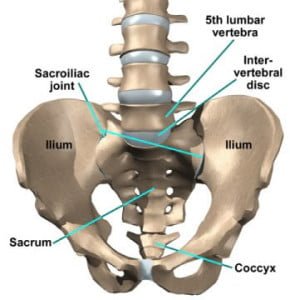“I think my pelvis is out!” This is something we hear often in the clinic. Using the term “out” to describe pain and/or discomfort in this area can be a little misleading. Rather that diagnosing a pelvis as being out, I tend to use language such as twisted, torsions and rotations. This is the first in a series on low back and pelvic pain.
Pelvic pain is usually associated with unilateral low back pain and/or buttock pain, which can sometimes radiate down the leg. There are many causes, but to keep this information simple and useful I will break them into three groups.
1. The bony anatomy and how it can change position (therefore appearing “out”).
2. Muscle tightness and imbalance.
3. Referred pain from the lumbar spine or hip joint.
Part 1 – BONES & JOINTS
First for some anatomy…
The pelvis consists of two ilia (the hips), the sacrum (the triangular bone) and the coccyx (the bone at the bottom of your spine). In the centre at the front, the two pubic bones are joined by cartilage known as the pubic symphysis and and at the back in between the sacrum and ilia we can find the sacro-iliac joint or “SIJ”. Other structures such as the lumbar spine and hips lie in close proximity and can also be involved.
The bony anatomy of the low back and pelvis is held together by the ligaments (kind of like sticky tape) that form a large system of levers and pulleys. If there is more tension on one part of the system, structures can become mal-aligned. This is easy to conceptualise when looking at the image above. One example is when one side of your pelvis rotates forward or backwards (us osteopaths refer to this as an anterior or posterior inomnant).
How do I know if there is something going on in my pelvis?
There are lots of symptoms, some of them are…
– Pain in the low back, buttock or hip
– Pain in the knee, ankle or foot
– Tightness or clicking in the low back or pelvic region
– A feeling of being off balance or things just not lining up properly in this area
– Headaches and migraines can also be a result of issues in the pelvis!
And what can my Osteopath do about it?
Your osteopath will treat your pelvis to restore correct alignment. This may involve things such as stretching, muscle release and manipulation. They will also look at other areas that may be contributing to the problem such as the low back and hips (to be covered in coming posts). Additional factors such as sitting posture and correct computer chair set-up should also be discussed.
Is there anything I can do?
Have a read of this previous post for some simple low back stretches. Or have a look at this article for some more in depth information.





